The chat is the place online where interaction takes place. It’s an essential part of livestreamed events, and maybe even our internet experience in general. When those of us who grew up with the internet look back on our own internet histories, we often don’t remember the websites we visited but instead we remember the chat conversations we had and the connections we made online.
We remember how, in our first chat experiences as young teens in the late 90s, we were peeking into topical chat rooms and starting up conversations with people we didn’t know. Instead of divulging all our personal data and private information in order to engage socially online, chatroom users were often identified by anonymous names and the only private information shared was A/S/L (age, sex, location). Back then, the internet was still a great voyage of discovery for us, and many users, and that discovery started in chatrooms. A few years later, instant messaging platforms like MSN, Yahoo Messenger, and ICQ took our social lives into a more hybrid form. We could connect with friends who we were in class with during the day, and hit them up on MSN messenger in the evening. These early chat platforms allowed for new ways to connect with one another, outside of social situations like school and work. And before Bumble and Tinder were even a glimmer of an idea, people were meeting new lovers and partners online—through chatrooms and instant messengers.
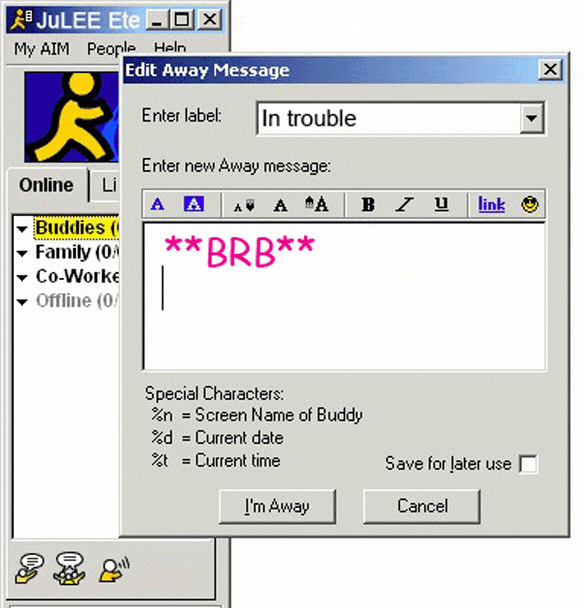
Although the first chat programs were founded by universities, they were used almost immediately for conversations about everything—about life. Talkomatic—born way before the World Wide Web, out of a computer-based education program at the University of Illinois in 1973—was one of the earliest forerunners of online chat, where only five people could chat at a time and where messages were displayed letter-by-letter as they typed. Every chat program that came after that had different qualities, attracting different kinds of groups and users. Compuserve, a commercial chat service from 1980, was able to exceed a hundred thousand users for the first time. IRC (Internet Relay Chat) was a network-based chat, developed in 1988 by Jarkko Oikarinen, that became popular as the internet became mainstream. Through IRC you could meet other internet users. You didn’t need an invite to IRC, anyone could join. From 1990, IRC rose in popularity, particularly when users started to use it as an information resource during the Gulf War. The next generation of chat platforms arose around the need for chatting with friends, like MSN Messenger. In the MSN era, being online was expensive and inconsistent so people weren’t continuously online yet. MSN users could choose different statuses: offline (you were online but others couldn’t see it), online (available to chat) or online but away ( you were online, but busy with something else). In our current online life—where we are always present, and that presence is also emphasized by check marks indicating that we have read a message, or dots indicating that we are typing—an ‘online but away’ status would be a warm welcome.
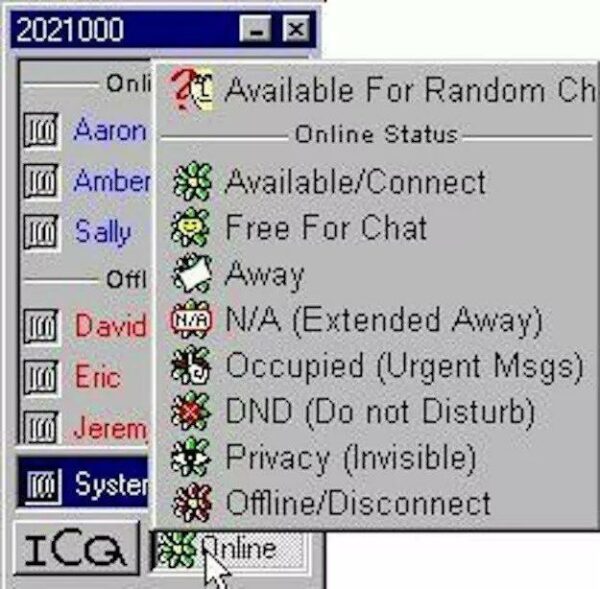
In addition to apps with the chat as their main function, like Signal, Telegram or WhatsApp, there is a chat on all social media platforms. Although taking place on a different time scale, even comment threads on platforms like TikTok, Instagram or news websites, are also an extension of the chat. The chat has an essential role on live streaming platforms such as Twitch, ensuring that the stream does not feel like a televised broadcast. Since most streamers immediately respond to what is said in the chat, and engage with the chat, viewers get the feeling of being part of an experience.
Although chat rooms have been around since the early days of the internet, a lot of organizations struggle with creating a lively and active chat during their events. During our online and hybrid events over the past two years, we noticed that chat rooms are a great way to bring online and onsite audiences together.
So, naturally, we wanted to share our five tips for a more vibrant and active chatroom with you:
1. Don’t underestimate the chat
During our last event, the very ambitious The Hmm @ 4 locations, we tried to use different elements to connect our onsite and online audiences together—like drawing games, our new atmospheric scent, and emotes. But in our survey that we did with our audience following the event, the chat was listed as the most successful way of bringing people together and creating connectivity. So don’t underestimate the power of the chat! Because of the long internet history we have with chatrooms and chat interfaces, we can often forget the value and importance of the chatroom, particularly for hybrid events. But it is precisely our familiarity with the chatroom, and its ease of use, that makes it the ideal interface to bring audiences together.
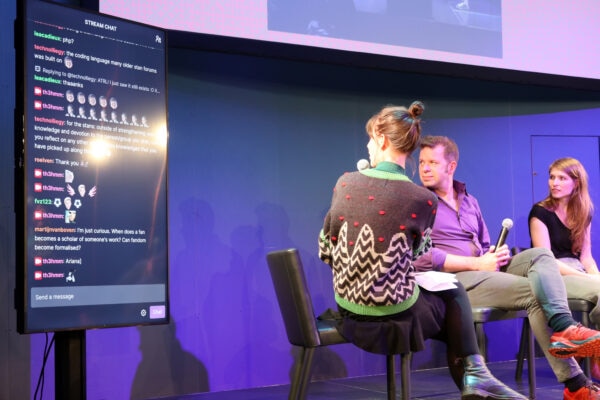
2. Remove barriers for access
Often, participating and interacting online involves making accounts and giving up some of your data and privacy. But the more hoops people have to jump through in order to interact with one another, the harder it will be for them to engage. That’s why we believe it’s important to make your chat room as accessible as possible. On The Hmm livestream website you don’t have to login or make an account to participate—just pick a chat name and you’re ready to go. We even added a new feature where you can control how long your chat name and data gets stored on our servers. Historically, the chatroom has been a place where strangers come together, so removing barriers to access also allows people to stay anonymous.
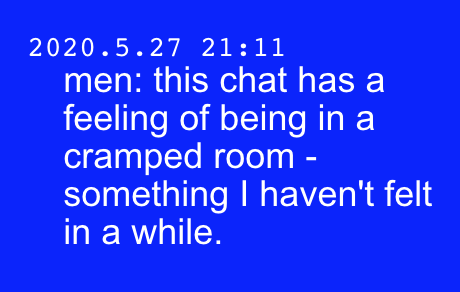
3. Moderation is key
Just like any gathering of strangers, it’s important to have someone present in that chat room who sets off that little spark in order to connect people and get conversations going. With The Hmm we always have a moderator in the chat who welcomes the audience, oversees the chatroom, shares relevant links and information, and updates the audience if there are any technical issues. We encourage conversations in the chat room by asking the audience questions during the break, finding out where they are watching from, asking quiz questions, and engaging with them throughout the program.
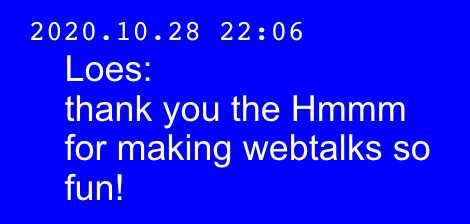
4. Choose your chat tools and platforms wisely
If, as Marshall McLuhan noted, “the medium is the message” than we need to think carefully about the tools and platforms that we use to chat. The chat tools and platforms that we use can influence the energy in the chat and the conversations that take place. During our The Hmm in Quarantine event, back at the start of the pandemic, we hopped from platform to platform to see which one would be best for cultural events. But what we also learned was the impact that different chat environments could have on our audience interaction. On Discord, for example, where there are lots of GIFs and custom emotes to use, the audience made use of these fun visual elements right away, filling up the chat room with them! While on YouTube and Zoom, which only allows you to use emojis and text, the audience was much more subdued and quiet. And even in our own livestream chat, we had a bit of an awkward design for filling in your chat name, which many users mistook for the place where they could write their first message—resulting in chat names like ‘Hi!’ and ‘I completely disagree with the person above me’. But this awkward design also influenced fun chat interactions, and a lot of laughs.
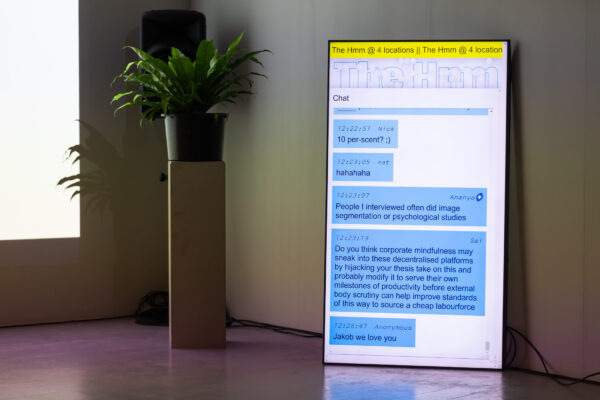
5. Bending hierarchy and proximity
Being physically present at an event is often seen as the more superior and better position—think about watching a concert on television versus being there live in the crowd. But with hybrid events you can play around with hierarchy and proximity by giving importance to the chat and the chatroom users during an event. Twitch is a great example of this, where Twitch streamers have the chat very prominent while they are streaming. This makes the presence of the audience much stronger. And on Twitch, some streamers even let the audience influence what happens in the stream based on what they say in the chat. During our The Hmm events we’ve been experimenting with having the chat room very prominent by having it on stage as a second screen, so the onsite audience can see what’s happening in the chatroom and connect with the online audience. Following our The Hmm ON Online Fandom event—where we used Twitch and created custom emotes that would float up on the screen as direct reactions from the online audience to speakers’ presentations —we integrated emotes into our livestream page that give the audience more presence in the online environment and allow them to share more reactions and emotions than they would if they were physically present onsite.
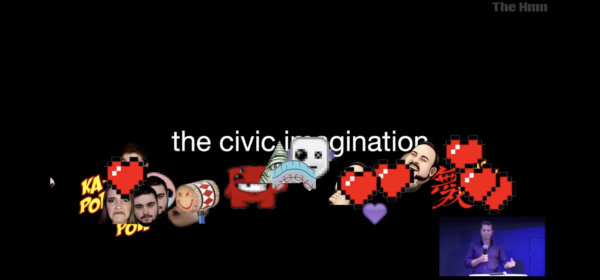
We hope these tips can help you elevate the chat to a whole new level in your hybrid events—and have a lot of fun doing it! (/^-^(^ ^*)/ ♡
And if you still haven’t read our first hybrid newsletter on the joy of getting ready, you can find it right here: https://thehmm.nl/the-hmm-hybrids-1-the-joy-of-getting-ready/